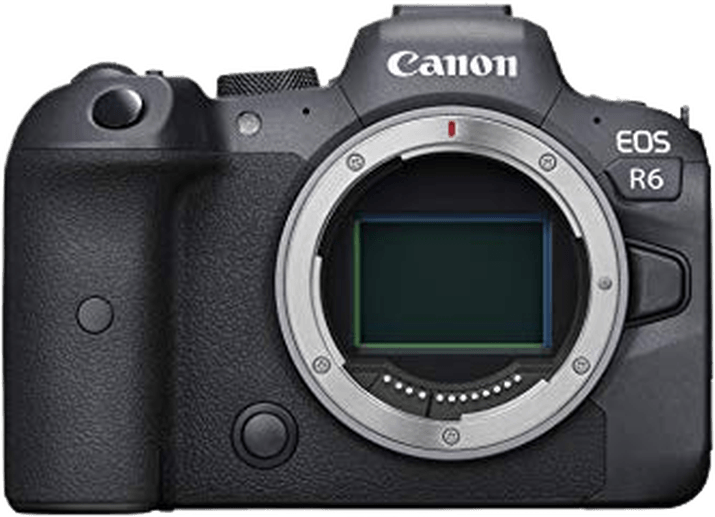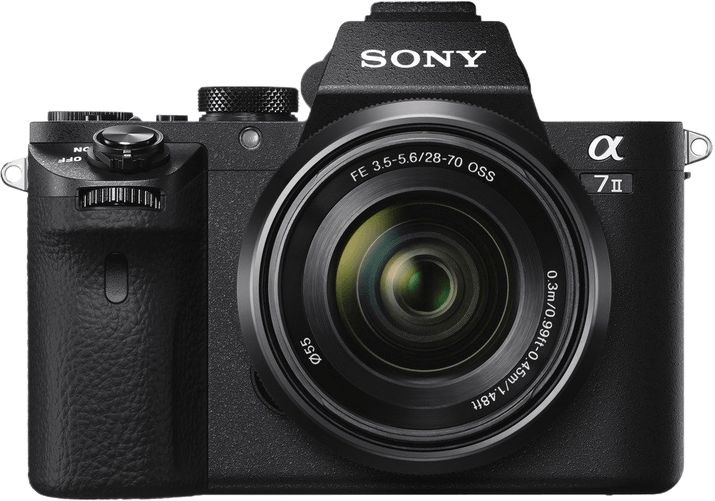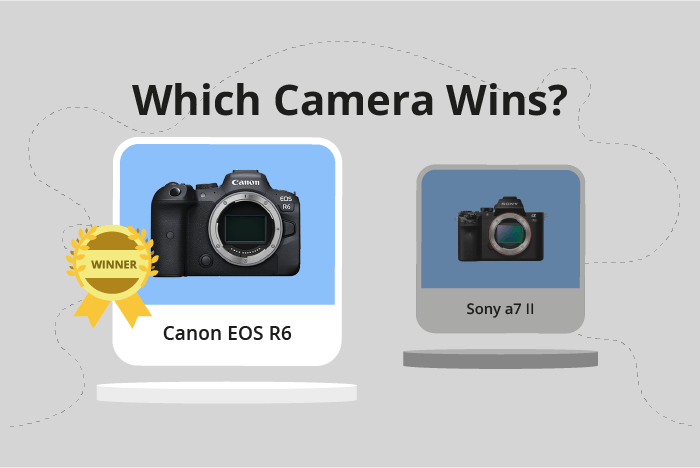Canon EOS R6 vs Sony a7 II Comparison
Canon EOS R6

Sony a7 II

The Canon EOS R6 outperforms the Sony a7 II with a score of 80/100 compared to 69/100. Both cameras are mirrorless and share similar dimensions, with the R6 measuring 138 x 98 x 88mm and weighing 680g, while the a7 II is slightly smaller at 127 x 96 x 60mm and lighter at 599g.
The R6, released in 2020, has the advantage of being a newer model, offering better performance and features for a launch price of $2499. On the other hand, the a7 II, released in 2014, has a lower launch price of $1600, making it more affordable for those on a budget.
Despite the lower score, the Sony a7 II remains a reliable option for those seeking a more compact and budget-friendly camera. However, the Canon EOS R6 stands out as the superior choice for those prioritizing performance and up-to-date features.
Canon EOS R6 vs Sony a7 II Overview and Optics
The Canon EOS R6 narrowly outperforms the Sony a7 II in terms of optics, with a score of 79/100 compared to the Sony’s 78/100. Both cameras share several common specifications including a CMOS sensor, full-frame sensor size, and image stabilization. Additionally, both cameras have the same DXOMARK score for their sensors, which is 90.
The Canon EOS R6 excels in certain areas, such as its shooting speed of 20 frames per second (fps), which is significantly faster than the Sony a7 II’s 5 fps. This advantage allows the Canon EOS R6 to capture fast-moving subjects more effectively. Moreover, the Canon EOS R6 features the Digic X processor, which provides faster and more efficient processing compared to the Sony a7 II’s Bionz X processor.
On the other hand, the Sony a7 II has a higher megapixel count, at 24.2 megapixels compared to the Canon EOS R6’s 20.1 megapixels. This means that the Sony a7 II can capture more details in its images, which can be beneficial for certain types of photography, such as landscapes and large prints.
In terms of lens mounts, the Canon EOS R6 uses the Canon RF mount, while the Sony a7 II uses the Sony E mount. This difference may affect the availability and variety of lenses for each camera, depending on the photographer’s preferences and needs.
Despite the Canon EOS R6’s slight edge in overall optics performance, both cameras offer strong features that cater to different photography styles and preferences. The Canon EOS R6 is better suited for action and sports photography due to its faster shooting speed, while the Sony a7 II is more appropriate for photographers who prioritize higher image resolution. Ultimately, the choice between these two cameras will depend on the individual photographer’s requirements and priorities.
Canon EOS R6 vs Sony a7 II Video Performance
The Canon EOS R6 outperforms the Sony a7 II in video capabilities, earning a score of 91/100 compared to the Sony a7 II’s 56/100. Both cameras share some common specifications, but the Canon EOS R6 ultimately provides superior video performance.
Both the Canon EOS R6 and the Sony a7 II offer max video resolutions of 4K and Full HD, respectively. However, the Canon EOS R6 boasts higher max video dimensions at 3840 x 2160, while the Sony a7 II only reaches 1920 x 1080. Additionally, the Canon EOS R6 has a faster max video frame rate of 120fps, double the Sony a7 II’s 60fps. The Canon EOS R6 also has built-in time-lapse functionality, which the Sony a7 II lacks.
The Canon EOS R6’s higher video score is due to its better video specifications, such as the greater max video dimensions and faster max video frame rate. These features allow the Canon EOS R6 to capture higher quality, smoother video footage compared to the Sony a7 II.
On the other hand, the Sony a7 II does not excel in any specific video aspect when compared to the Canon EOS R6. Its lower video score reflects its inferior video capabilities and performance.
Considering these points, the Canon EOS R6 is the clear winner in terms of video capabilities, providing users with better video quality, smoother footage, and additional features such as time-lapse functionality. The Sony a7 II falls short in comparison, making the Canon EOS R6 the superior choice for videographers and content creators.
Canon EOS R6 vs Sony a7 II Features and Benefits
The Canon EOS R6 outperforms the Sony a7 II in features, scoring 85/100 compared to the Sony’s 57/100. Both cameras share several specifications, such as a 3-inch screen size, flip screen functionality, the absence of GPS, and WIFI capabilities.
The Canon EOS R6 has a higher screen resolution of 1,620,000 dots, compared to the Sony a7 II’s 1,230,000 dots. This results in a sharper and clearer image display on the R6. Additionally, the R6 possesses a touchscreen, making it more user-friendly for photographers to navigate through settings and review images. The Canon EOS R6 also has Bluetooth connectivity, providing an additional option for transferring images wirelessly.
In contrast, the Sony a7 II lacks a touchscreen and Bluetooth connectivity. Despite these shortcomings, the camera still offers a flip screen and WIFI capabilities, which are valuable features for various photography styles and situations.
To conclude, the Canon EOS R6 surpasses the Sony a7 II in terms of features, with a higher screen resolution, touchscreen, and Bluetooth connectivity. These enhancements contribute to a more enjoyable and efficient user experience. While the Sony a7 II falls short in comparison, it still provides essential features such as a flip screen and WIFI capabilities. Ultimately, the Canon EOS R6 is a superior choice for photographers seeking advanced features and a more user-friendly experience.
Canon EOS R6 vs Sony a7 II Storage and Battery
The Canon EOS R6 outperforms the Sony a7 II in storage and battery, scoring 68/100 compared to the Sony a7 II’s 35/100. Both cameras accept SD, SDHC, and SDXC memory cards, but the Canon EOS R6 has two memory card slots while the Sony a7 II has only one. Additionally, the Sony a7 II accepts Memory Stick Duo, Pro Duo, and Pro-HG Duo cards.
The Canon EOS R6 boasts a battery life of 360 shots, slightly more than the Sony a7 II’s 350 shots. The Canon EOS R6 uses an LP-E6NH battery and offers USB charging, making it more convenient for on-the-go charging. The Sony a7 II relies on an NP-FW50 battery.
While the Canon EOS R6 provides better storage and battery options, the Sony a7 II offers compatibility with Memory Stick cards, which may be beneficial for some users. However, the Canon EOS R6 clearly has the advantage in this category, with more memory card slots, longer battery life, and USB charging.
Canon EOS R6 vs Sony a7 II – Our Verdict
Are you still undecided about which camera is right for you? Have a look at these popular comparisons that feature the Canon EOS R6 or the Sony a7 II:

